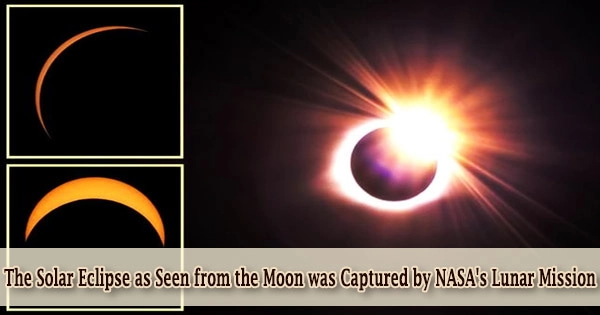The Lunar Reconnaissance Orbiter, or LRO, obtained an image of the Moon’s shadow across a broad swath of the United States, centered just north of Nashville, Tennessee, during the total solar eclipse on August 21, 2017.
The shadow of the Moon was speeding across the United States at 1,500 mph (670 meters per second) as LRO reached the lunar south pole traveling north at 3,579 mph (1,600 meters per second).
LRO began a gradual 180-degree rotation to face back at Earth a few minutes later, obtaining an image of the eclipse near the point where totality lasted the longest. At 2:25:30 p.m. EDT (18:25:30 UTC), the spacecraft’s Narrow-Angle Camera began scanning Earth and finished the photograph 18 seconds later.
The Lunar Reconnaissance Orbiter Camera system includes the Narrow-Angle Camera. Two Narrow-Angle Cameras take high-resolution black-and-white photographs, while a third, the Wide Angle Camera, takes moderate-resolution images with filters to provide information about the lunar surface’s characteristics and color.
Rather with the more common “instantaneous” framing that occurs with digital or cell-phone cameras, the Narrow-Angle Camera generates an image line by line. Each line in the image is exposed for less than a thousandth of a second; the exposure period was kept as short as possible to avoid overwhelming the sensor with bright clouds. The acquisition of all 52,224 lines for the image takes roughly 18 seconds.
On Earth, the joy of the total eclipse was seeing the Moon’s shadow pass across us, but on the Moon, it was simply another day.
The Sun shined on the far side in the middle of its two-week day, while the lunar nearside was one week into its two-week night. LRO operated normally during the total solar eclipse because solar eclipses have no effect on the spacecraft’s health or power supplies.
LRO, which was launched on June 18, 2009, has collected a wealth of data with its seven-strong sensors, contributing significantly to our understanding of the Moon and reminding us of the beauty of our planet through these eclipse photographs.
LRO is a NASA Discovery Program project operated by NASA’s Goddard Space Flight Center in Greenbelt, Maryland. NASA’s Marshall Spaceflight Center in Huntsville, Alabama, manages the Discovery Program for the Science Mission Directorate at NASA Headquarters in Washington.
Malin Space Science Systems in San Diego, California, and Arizona State University collaborated on the Lunar Reconnaissance Orbiter Camera.





